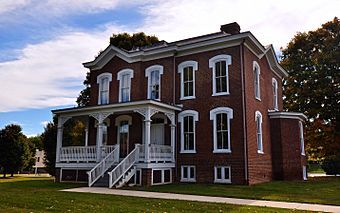Glencoe Museum facts for kids
The Glencoe Museum is a cool place to visit in downtown Radford, Virginia. It's located inside a beautiful old house that was built way back in the 1870s. This house is a great example of Victorian architecture, especially a style called Second Empire architecture. It used to be the home of a famous person named Gabriel C. Wharton, who was a general during the American Civil War.
This large brick house has two stories and five main sections. When it was first built, it had a lot of land around it. The property even had its own barn, a chicken coop, a smokehouse for preserving food, and an ice house to keep things cold!
The name "Glencoe" might have come from Anne Wharton's family, who were originally from Scotland. Building such a big and fancy house took a long time in the 1800s. The house first appeared on Radford's tax records in 1876. The Wharton family owned Glencoe until 1996. After being empty for about 30 years, the house was given to the city of Radford.
Discovering Glencoe Museum
The Glencoe Museum is a fantastic spot to learn about the history of Radford. Inside the house, you can explore rooms that look just like they did during the Victorian era. It's like stepping back in time!
What You Can See Inside
The museum has many interesting displays that tell the story of Radford.
- Native American History: Learn about the first people who lived in this area.
- Early Settlers: Discover how the first European families came to live here.
- Mary Draper Ingles: Find out about the amazing journey of a brave woman named Mary Draper Ingles.
- Local Industries: See how people worked and what kinds of businesses were important in Radford's past.
- Transportation: Explore the history of railroads and river travel that helped Radford grow.
- Education: Learn about the schools and colleges that have shaped the community.
- Local Sports: Check out displays about Radford's sports heroes and teams.
Art and Creativity
Besides history, Glencoe Museum also has an art gallery. This gallery often features new exhibits by artists from the Appalachian Mountains region. It's a great way to see modern art and learn about local talent.
A Historic Landmark
Because of its important history and beautiful architecture, Glencoe was officially recognized as a historic place. It was added to the National Register of Historic Places in the year 2000. This means it's a special building that is protected and celebrated for its historical value.




